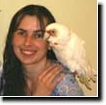External Parasites in Gouldians
& Other Small Finches
Kristen Reeves, Meadowlark Farms Avian Supply, Inc.
As bird keepers, we all know the importance of keeping cages clean and observing our birds closely each day for changes in behavior and health. It is my hope that once you've read this information, it will reinforce the importance of these duties and express to you the urgency of finding problems early.
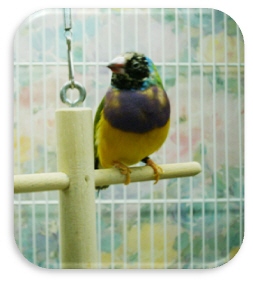
This Cock is a prime example of what can happen when your bird has had some kind of parasite. In this case, he began his juvenile molt just before a Blood Mite infestation took over the aviary. In this photo, he is over a year old, and just beginning to finish his molt after treatment. Because of the infestation, he also suffered from worms, scaly face mites, and anemia. He is now fully recovered from the other issues, but is on a high-calcium, iodine, iron and protein regimen until I decide he is healthy enough for a regular diet.

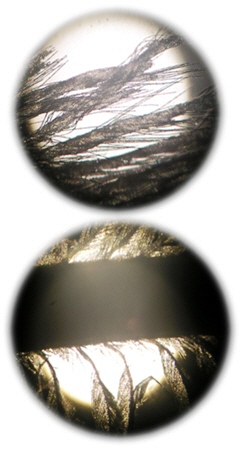
Mites and lice come in all different shapes and sizes. Some will remain on the bird and attack it while others will go off and hide in a dark space. Occasionally you may find a mite that visited your bird room but is not actually one that will affect the birds. Dust mites and those that eat book fiber are occasionally found around my bird room. I use Diatomaceous Earth sprinkled around to dehydrate any little bugger that tries to sneak in unannounced, but the friendly spiders usually take care of those I miss!
![]()
I'd like to point out that while bleach and hot water are great disinfectants when cleaning cages, I have found they DO NOT kill some of these parasites or their eggs. I have found that the ONLY effective pesticide for external mites is a Pyrethrin based product such as Avian Insect Liquidator or Sevin (which is Carbyl). The problem here is that all of the mite species you may encounter have different life cycles; therefore it is imperative that you correctly identify the mite and treat accordingly. I have also found it very difficult to find consistent information on actual life cycles for some mites and treat for ALL mites as if their life cycle is 3 to 7 days, repeating the treatment until I'm certain there are no more eggs (which is very hard to determine). It has been my experience that the only way to eliminate externals mites from your birds and their environment is to first treat the birds with an external pesticide, then apply Scatt (Moxidectin) every 21 days (recommended dosage) for several months. Bathing in S76 (Ivermectin) will remove external mites as well, but from what I can tell, is not effective on the eggs.
MITES
BLOOD MITES
Unfortunately, I've become somewhat of an expert on blood mites having encountered an infestation that took over a year to completely eradicate. Blood mites are the Dracula of the bird world and are known to the general population as “chicken mites”. No matter what any other website says, they are VERY difficult to eradicate - I have firsthand experience to prove it - and I caught them early!
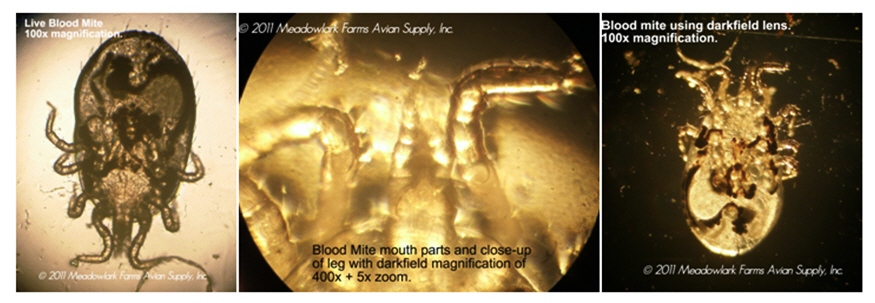
Under the microscope, the mites look like miniature crabs with 8 legs and a sharp mouth. The newly hatched young appear white, not unlike bird dander or dust. The eggs are not visible to the naked eye, but can be seen with 600x magnification. To the naked eye, they appear as tiny specks, no larger than a grain of salt. The mites breed in warm dry places but need humidity for the eggs to hatch.
The mites then go through several life stages. Only the females feed and are only able to mate and feed during a specific stage of their life - hence catching them early and stopping them during those phases is essential. They feed on the birds when they roost for the night, or settle down in their nest boxes. After feeding, the mites will appear a brownish red to bright red much like those fast little red spiders we may see climbing on us after a walk through our gardens. They will colonize in any dark, dry space such as the ends of wooden perches, under the flaps of sheet metal cage trays, in the cracks of molded sand perches that have begun to separate, nooks and crannies of Manzanita perches; anywhere they can squeeze that is warm, dry, and within a relatively close proximity to their nightly meal.
If not stopped quickly, they WILL move to other parts of the structure and feed on humans and other pets if there are no birds to feed on.
After many, many long hours of research, I have only found conflicting information about their life cycle. Some experts state that the mites and their eggs can remain dormant for up to six months and can go without a blood meal just as long, others say it takes a mere few days without a meal for them to die. I've also read that it appears they require a higher humidity to reproduce. In an effort to have successful breeding season for my birds, I had cooked my own goose - so to speak. I had set up a very large aquarium without a hood to allow evaporation and aid in raising the humidity level in my bird room. I was also running an additional heater to keep the room at 70+ degrees. The combination of the high heat and humidity gave the dormant mites and eggs in the cages the right environment to go bonkers!
After much research, eggs can remain dormant for...well, it seems like forever! Having purchased used cages that were apparently FULL of eggs - even after completely dismantling them, cleaning them in hot bleach water, allowing them to dry in the hot sun, hand dropping Pyrethrin into nooks and crannies, and repainting them to seal cracks - I have come to the conclusion that the only way to be certain you have eliminated them completely is to destroy your bird's cage(s) and replace it. You must then completely wash, dry and treat areas around where your bird is housed, and be extremely vigilant for ANY signs of additional infestation. I use a jewelers loop to this day to scrutinize every little speck that looks suspicious.

Many breeders, pet stores and even Veterinarians will tell you that the mite will only travel as far as three feet in any direction around their meal. In my experience, this is just not the case! They will travel clear across a room to hide. I had found them in the ceiling tiles of a drop ceiling, and under wall paper, in my lights on the ceiling, and in electrical outlets. None of which are within a three foot radius of my birds' cages. So the three foot rule is a bunch of bunk! They multiply very rapidly, as the female lays hundreds of eggs at a time. If you suspect your birds are infested with blood mites, it is imperative you eliminate them quickly or you could be their next meal and your birds could die from complications including, but not limited to, anemia, protozoal infections, scaly face mites, air sac mites, bacterial infections, etc!
My recent study of the blood mite (2011) has found that after 2 days of no feeding the adult mites will die. I was not able to test nymphs, but I did find that unless the female is able to feed, the young in the eggs within her will also die. Unlike the air sac mite whose young will feed on their dead mother, it appears these little guys are done for! The photos below show a live blood mite at 100x magnification. The video also shows the live mite and its mouth parts and legs moving. Watch the insides carefully, you'll be able to see eggs and the young moving within them.
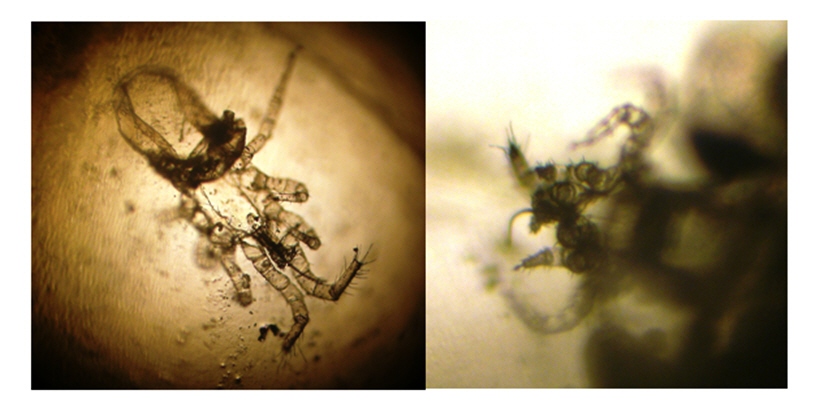
The above two photos show two dead blood mites found in used cages & lights that were given to me. I had stored them in the garage as a precautionary measure until I was able to make a very close inspection with my jeweler’s loupe. I noticed some odd specks, so picked these up with Scotch tape to view under the scope, hence the oddly dark background. I'm relieved I did not bring the cages in! Had I brought them in the house, I could have started an entirely new infestation as there were also signs of dormant eggs and nymphs in the both the lights and cages! One more bullet dodged! NEVER PURCHASE USED CAGES!!!
Read the FULL SAGA here
FEATHER MITES
These mites spend their entire life on the bird and also suck their blood. They can cause extreme irritability, respiratory infections, anemia, and lethargy. They have elongated bodies and usually stay close to the shaft of the individual feathers and are often lined up like little soldiers along the shaft. They cannot always be readily seen with the naked eye and a microscope may not show them unless you pluck a fresh feather and immediately place it under the scope at 100x magnification before they run off the feather.
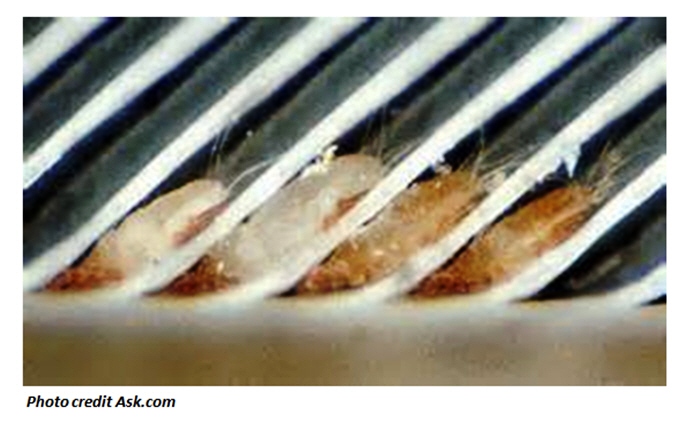
An external parasite spray such as Avian Insect Liquidator is usually effective against these mites, but treatment will take several applications as the eggs hatch. Spray the birds down completely every three days for one full week (plus two days) to break the life cycle. You can also dust Sevin on the birds and in nest boxes to keep these mites away.
BURROWING MITES
These mites (Epidermoptic mites) burrow under the skin and leave a scaly, scabby appearance on the skin. As with other mites, birds will become extremely agitated and act nervous. While most burrowing mites remain regularly. These mites are sometimes the cause for balding in Gouldians when an iodine or other nutritional deficiency has been eliminated as a cause, but may cause obvious problems, as in the photos to the right, on other parts of the body.
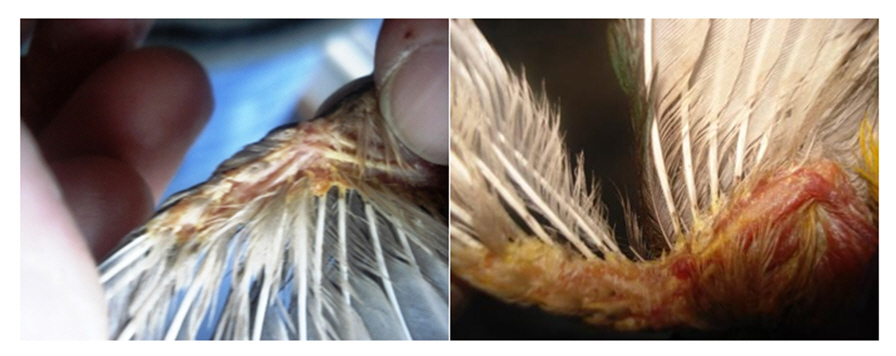
These mites can USUALLY be eliminated by using Scatt along with S76 in the drinking water and Avian Insect Liquidator externally. Because these mites will cause the bird to scratch at open wounds, a secondary infection is often seen. A broad spectrum antibiotic is often needed – but should NOT be given at the same time as the parasite control items.
SCALY FACE & SCALY LEG MITES
Scaly face and leg mites are microscopic mites that burrow into the beak and leg scales of your bird. While not the same mite, they do belong to the same species known as Knemidokoptes. You may not see both scaly face and scaly leg mites at the same time - you may see ONLY scaly face mites OR scaly leg mites. This is not unusual. However, the treatment is the same for both.

Scaly face mites will often appear first in the corners of the beak where tiny sores may begin, though they may never appear at the corners at all and only attack the beak and or legs. As they spread, they burrow trails that look “dusty” in their path. You may see what looks like small holes in the surface of the bird's beak. They may also spread back onto the skin of the head causing feather loss usually first around the eyes, then from the beak on back.
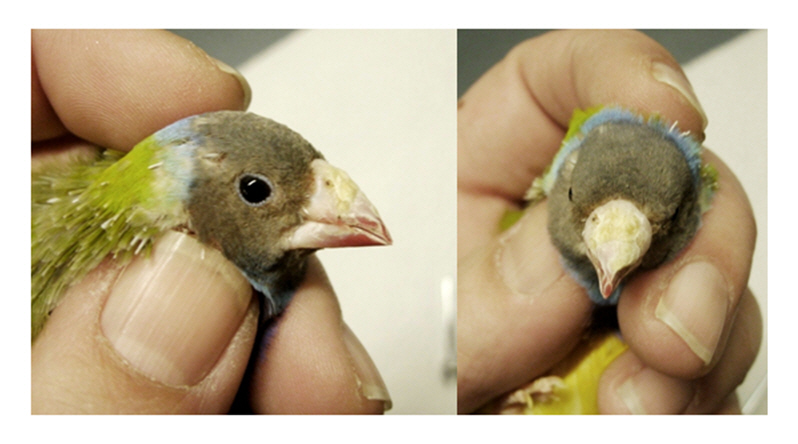
Some birds will present with a thick waxy build-up on their beaks that may appear white, yellow or brownish. This will flake off as the mites burrow and the beak grows. Cases may be very slight or extremely heavy depending on how soon the mite infestation was caught.
CONSISTENT treatment with Scatt or S76 (Ivermectin) will eliminate mites, but it may take many treatments and several months for the damaged beak to grow out normal.
It is important to keep cages and cage accessories immaculately clean while treatment commences. Perches must be changed daily to stop recurring infections - as birds wipe their beaks on perches, the mites can be transferred.
While the presence of scaly face itself is not life threatening, it can cause severe deformity of your bird's beak if not treated. A deformed beak can make it very difficult for seed eating birds to crack seed, eventually starving them to death.
Mites on the legs will force the normally smooth scales to raise up. The scales may look grey, brown or bluish in color. Severe cases are often called “tassel foot” due to the small hanging tassel-type tags that grow out and away from the feet.

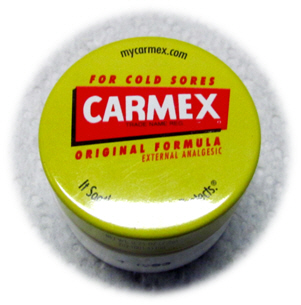
It must also be noted that older birds may grow calcium deposits on their legs as they age. These will look somewhat like leg mites, but once you've seen the actual infection, you will be able to determine the difference.
When treating for scaly mites (both face & leg), Scatt & S76 should be administered consistently as directed on the labels. In addition, I like to pick off loose chunks from the beak and lift loose scales off the legs when I treat the birds. I will often lightly file beaks first.
Treatment for Scaly Face Mites here consists of –
- Lifting loose scales off the beak with my fingernail
- Lightly filing the beak to remove any remaining loose scales then coating with UNDILUTED S76
- Once the S76 is dry, I coat the beak with Carmex (an oil based menthol & camphor lip balm)
- TREATMENT IS DAILY FOR SEVERAL WEEKS UNTIL THE MITES ARE GONE
Treatment for Scaly Leg Mites here consists of -
- Leg scales are coated FIRST with Carmex DAILY for several days and allowed to soften
- Once leg scales have softened, I lift them off using my fingernail, tweezers or nail clippers
- When the scales have been mostly removed, I then coat the legs with UNDILUTED S76
- Once the S76 is dry, I then coat the legs and feet with Carmex
- TREATMENT IS DAILY FOR SEVERAL WEEKS UNTIL THE MITES ARE GONE
FINAL WORD...
The information contained here is for reference purposes only. As always, if you suspect your bird is sick, take it to an Avian Veterinarian!




